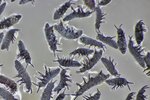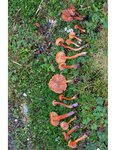


‘The Deceiver’, Laccaria bicolor, is a simple pinkish mushroom with purplish gills that can be found growing just about everywhere on sandy forest floors, like those near coastal regions and our town of Manchester. It is an excellent symbiotic partner with many types of trees, most significantly the mighty White Pine which dominates so much of our New England forests. After all, 95% of all the trees and shrubs and grasses on earth have some sort of fungal partner living under the soil helping them obtain water and minerals. The Deceiver is one of the pine forest’s best friends and they get paid back handily with the sugars the trees produce through photosynthesis. However, the Deceiver conducts an almost sinister double-life in the dark world under the forest floor.
Laccaria mushroom species have thick broad gills which are often purple or pinkish and attach directly to the stem. Their cap is orange to reddish-brown but occasionally whitish. It is convex when young and flattens out with age when the cap margin can become seriously split or torn. They can have white or purplish colors at the base of their fibrous stem. Laccaria are associated with White pines, but also hardwoods like beech, oak, and birch. All of this adds up to a highly variable mushroom which can grow in a variety of habitats. The species Laccaria bicolor is distinctive in that the base of its stem is purple, not white, a telltale feature, and it grows with pine trees, not hardwoods like some of its cousins.
Another creature of the soil are the Springtails, those tiny little wingless Snow Fleas one sees jumping on top of snow in late winter. They are one of the soil creatures that eat the mycelia of fungi that grow in the soil. Mycelia are the delicate, extensive thread-like tissues that comprise the fungus itself. Lots of soil creatures nibble away at mycelia because they are either carrying minerals to share with trees, or receiving sugars that the trees feed back to them. Either way, the mycelia of fungi is a tasty treat.
Alas, the Deceiver has developed a way to fight back. They exude a type of poison to defend themselves which paralyzes the springtails, giving them enough time to envelop them with their mycelia and, in effect, eat them. During this process, the Deceiver emits enzymes which digest and break down the springtails body releasing their nutrients, most importantly, the nitrogen within them. The Deceiver then passes these minerals on to the White Pine trees that they have a symbiotic relationship with. Nitrogen is a key element in the constantly moving highway system of chemicals in the forest soil mix and fungi are the primary means for trees to get access to it. Their enzymes remove it from the soil and the bodies of creatures like the springtails and transform it into a form that the trees can make use of. In exchange, the photosynthetic trees share up to about one-third of the sugars they produce with their symbiotic fungal partner the Deceiver. It is a complex and very sophisticated system of exchange and movement going on under our feet as we walk into our majestic woodlands, but also a very successful one. The world of symbiotic relationships in nature can be quite beautiful, almost poetic, but for some creatures, it can also spell their doom.
Gary Gilbert is a member of the Executive Committee of the Boston Mycological Club, lectures and leads identification walks in the area, and is the author of “Mycocards”, flashcards for learning mushroom identification (www.mycocards.com). He lives in Manchester-by-the-Sea.